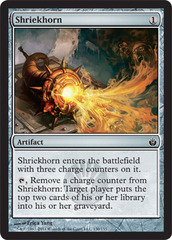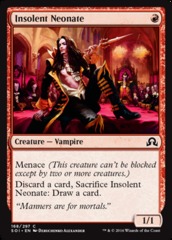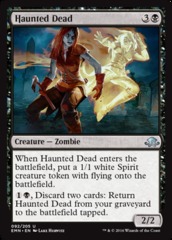Dredge Download

Anyone that has knows me knows that I am a dredge player in Modern. Last year the deck took me to two fairly high profile victories at both the MKM series London modern event and the third English WMCQ in the space of just two weeks – with an overall record of 17-0-4 (with three of the draws being intentional) proving that when under the radar, the deck is almost unbeatable. As the deck I have had the most success and experience with, I thought it was only right that I write an article on both my experiences with the deck and my opinion on its position in the current metagame and how I would approach building the deck to combat the Death’s Shadow dominated field in modern.
The emergence of ‘fair’ Death’s Shadow decks (and of course the banning of Golgari Grave-Troll) has presented an interesting conundrum to dredge players. On the one hand, dredge has a fantastic matchup against both the Grixis and Jund shadow variants. On the other hand, as a result of the rise of these decks, graveyard hate has become way more popular and a lot of decks have upwards of 5 sideboard cards that completely shut down the dredge deck (Leyline of the Void being the prime offender). Without the speed that Grave-Troll and Stinkweed Imp gave the deck when combined, we can no longer rely on explosive openings and going under opposing hate cards, meaning that we have to slog through cards like Rest in Peace and Grafdigger’s Cage with multiple answers. Here’s the list that I would use to do just that:
| CREATURES (20) | |
| 4 Prized Amalgam | |
| 4 Bloodghast | |
| 4 Narcomoeba | LANDS (20) |
| 4 Stinkweed Imp | 4 Scalding Tarn |
| 2 Insolent Neonate | 3 Bloodstained Mire |
| 2 Golgari Thug | 2 Stomping Ground |
| 2 Blood Crypt | |
| INSTANTS AND SORCERIES (16) | 2 Gemstone Mine |
| 4 Faithless Looting | 3 Blackcleave Cliffs |
| 4 Cathartic Reunion | 2 Copperline Gorge |
| 3 Conflagrate | 2 Mountain |
| 4 Life from the Loam | |
| 1 Darkblast | SIDEBOARD |
| 2 Lightning Axe | |
| ARTIFACTS (4) | 1 Ancient Grudge |
| 4 Shriekhorn | 2 Collective Brutality |
| 2 Thoughtseize | |
| 3 Nature’s Claim | |
| 2 Engineered Explosives | |
| 3 Leyline of the Void |
Yes that does say Shriekhorn!

On the surface, Shriekhorn appears to be a pretty poor magic card. It is card disadvantage, doesn’t mill multiple cards in a row (meaning that Narcomoebas hit off of the first activation won’t trigger Prized Amalgams off of the second one) and it doesn’t dig for sideboard cards post-board like other enablers such as Faithless Looting and Insolent Neonate do.

Despite these factors, I have opted for the full four copies – double the quantity of Insolent Neonates! The reason for this, for the most part, is consistency. The best way to think of Shriekhorn’s activated ability is as a dredge of 6 over the course of two (and a half) turns. Who needs Golgari Grave-Troll anyway?
The popular alternative Insolent Neonate requires a lot of moving parts to fall into place in order for it to perform to maximum capacity. Shriekhorn, however, not only is a ‘one man band’ but also allows you to keep a hand without any dredge cards as it can effectively dig 4 cards deep to find one. Consider the difference between these two hands:
Insolent Neonate, Cathartic Reunion, Narcomoeba, Prized Amalgam, Wooded Foothills, Blackcleave Cliffs, Copperline Gorge
Shriekhorn, Cathartic Reunion, Narcomoeba, Prized Amalgam, Wooded Foothills, Blackcleave Cliffs, Copperline Gorge
By just replacing Neonate with Shriekhorn we turn a mulligan into a pretty fantastic keep. Furthermore, by playing 10 one mana enablers on top of 4 copies of Cathartic Reunion, we limit the number of hands that need to be mulliganed. Hands with only Insolent Neonate or Shriekhorn as an enabler generally are too slow to keep but by playing more copies, we can more reliably curve a turn one enabler into a second (or maybe even a third) enabler by the second turn. It is only with hands like these that the current iteration of dredge can replicate the busted starts of the deck before the changes to the modern banned and restricted list.
Playing 14 enablers (15 if we include Darkblast) also gives the deck a lot of added resiliency against the numerous discard and counter spells that plague modern. To beat Grixis Death’s Shadow you need to try and match them on efficiency; using all your mana each turn and getting your game plan online quickly is a vital part of doing this. Similarly, in matchups that are typically unfavourable like Eldrazi Tron, RG Valakut and Ad Nauseum it is important to find around 7 power’s worth of creatures to fight through their hate cards or force them to use up resources like Angel’s Grace.
In order to fight on this axis, sacrifices did have to be made:



One problem with dredge is that you are very limited in your deck building. Dipping lower than 11 dredgers is a mortal sin and the 12 recursive creatures are obligatory. After adding extra enablers there is no longer any room for these more narrow cards. Haunted Dead’s strengths come in making hands with one enabler more consistent and being a recursive threat. We are already wanting to maximize two enabler hands and the recursive ability generally benefits the good matchups more than the bad. Additionally, as we are trying to maximize explosive potential, anthem effects become less necessary as we can replace a late burst of damage with consistent early damage. Of course there are risks but something had to go!
My current sideboard is fairly self explanatory: beat the hate. Whether the hate is specific cards or an entire strategy, my sideboard is built to fix problems that are posed in games 2 and 3. Bad matchups like combo and big mana decks are battled with a combination of artifact hate and discard spells while hate cards are battled with Nature’s Claim and Engineered Explosives, the latter of which serves a dual role in dealing with artifacts and enchantments as well as Tarmogoyfs, Scavenging Oozes and tokens. Leyline of the Void is a trump card that stops Grixis Shadow dead in its tracks and is of course a crucial tool in the mirror match. Although these cards have very specific roles, Lightning Axe and Collective Brutality are perhaps the two most important cards in the sideboard. The reason for this is that they not only have application in a variety of matchups but that they also serve as discard outlets and can therefore swap easily with cards like Shriekhorn and Neonate. This means that you can bring in effective sideboard cards without diluting your game plan too much.
Hopefully you’ve all found this article useful and are inspired to take this deck out for a spin – and then spill half of it into the graveyard! In my next article we’ll be looking at sideboarding against all of the most popular decks in modern and also the approach a dredge player should take in any given matchup.
If you have any questions, please feel free to comment below and I will do my best to answer them as quickly as possible. Oh, and keep on dredging!





